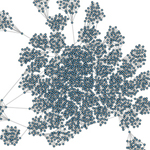Research Projects
Structure and Infectious Disease Transmission
 Understanding the dynamics of epidemics is of paramount importance for eliminating and controlling infectious disease. A rich body of research has provided major insights into the processes that drive epidemics, and has been instrumental in developing strategies of eradication and control. One of the central theoretical concepts in epidemiology is the basic reproduction number, R0, which is defined as the expected number of secondary infections produced by a single, typical primary infection in a completely susceptible population. R0 is the growth rate in infections early on in an epidemic. Traditionally, this quantity has been treated as a measure of biological "infectiousness" of a pathogen, but this view is flawed. R0 is a measure of the growth of infections and, as such, is fundmendally affected by population structure. Epidemiological patterns seen in the spread of directly transmissible diseases such as HIV/AIDS, SARS, influenza, gonorrhea, etc. can only be explained if contact network heterogeneity is taken into account. Indeed, there is increasing evidence that this is also true for indirectly (e.g., vector-borne) diseases such as malaria and dengue fever. Thus, social structure, and the processes that underlie its formation, is a fundamental feature of the transmission and control of infectious agents. Unfortunately, traditional epidemiology often lacks both the theoretical and methodological tools for understanding the contribution of social structure to both disease dynamics and control.
Understanding the dynamics of epidemics is of paramount importance for eliminating and controlling infectious disease. A rich body of research has provided major insights into the processes that drive epidemics, and has been instrumental in developing strategies of eradication and control. One of the central theoretical concepts in epidemiology is the basic reproduction number, R0, which is defined as the expected number of secondary infections produced by a single, typical primary infection in a completely susceptible population. R0 is the growth rate in infections early on in an epidemic. Traditionally, this quantity has been treated as a measure of biological "infectiousness" of a pathogen, but this view is flawed. R0 is a measure of the growth of infections and, as such, is fundmendally affected by population structure. Epidemiological patterns seen in the spread of directly transmissible diseases such as HIV/AIDS, SARS, influenza, gonorrhea, etc. can only be explained if contact network heterogeneity is taken into account. Indeed, there is increasing evidence that this is also true for indirectly (e.g., vector-borne) diseases such as malaria and dengue fever. Thus, social structure, and the processes that underlie its formation, is a fundamental feature of the transmission and control of infectious agents. Unfortunately, traditional epidemiology often lacks both the theoretical and methodological tools for understanding the contribution of social structure to both disease dynamics and control.
With more than 300 infectious diseases emerging within less than a century, the recent threat of pandemic influenza posed, for example by novel influenza A(H1N1) or A(H5N1) is only the latest of many public health challenges posed by infectious diseases in a globalized world. Unlike pharmaceutical interventions, non-pharmaceutical interventions (e.g., social distancing) can be effective in halting or at least mitigating an epidemic independently of the specific biology of a pathogen, and thus provide a reliable set of strategies to combat infectious diseases that warrant further attention. However, the ability to predict and control the spread of flu-like infectious diseases strongly depends on the underlying assumptions about the contact network. The data we have collected -- and continue to collect -- allow us to study the spread of diseases and potential strategies to control them at a level of unparalleled precision. The data and simulations based on the data (e.g., Salathé & Jones 2009; Salathé et al. 2010) provide important information for public health polices. Furthermore, the data are also of fundamental interest to the field of social networks, as the data we are able to collect are of extremely high precision.
Our work involves both the development of mathematical and computational models of disease transmission in complex populations and the careful measurement of the substrates on which infections are transmitted.
PI: Jamie Jones
Collaborators: Marcel Salathé (Penn State University), Dan Salkeld (Stanford and California Department of Public Health), Marc Feldman (Stanford Biology Dept), Phil Levis (Stanford Dept of Computer Science)
